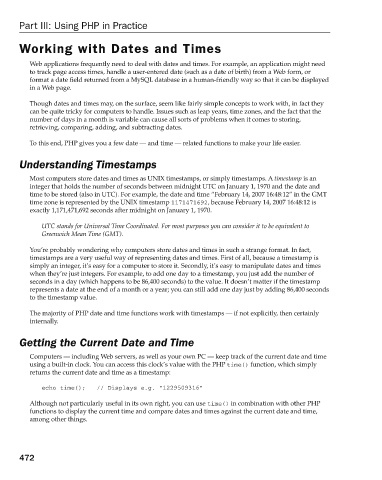Page 510 - Beginning PHP 5.3
P. 510
Part III: Using PHP in Practice
Working with Dates and Times
Web applications frequently need to deal with dates and times. For example, an application might need
to track page access times, handle a user - entered date (such as a date of birth) from a Web form, or
format a date field returned from a MySQL database in a human - friendly way so that it can be displayed
in a Web page.
Though dates and times may, on the surface, seem like fairly simple concepts to work with, in fact they
can be quite tricky for computers to handle. Issues such as leap years, time zones, and the fact that the
number of days in a month is variable can cause all sorts of problems when it comes to storing,
retrieving, comparing, adding, and subtracting dates.
To this end, PHP gives you a few date — and time — related functions to make your life easier.
Understanding Timestamps
Most computers store dates and times as UNIX timestamps, or simply timestamps. A timestamp is an
integer that holds the number of seconds between midnight UTC on January 1, 1970 and the date and
time to be stored (also in UTC). For example, the date and time “ February 14, 2007 16:48:12 ” in the GMT
time zone is represented by the UNIX timestamp 1171471692 , because February 14, 2007 16:48:12 is
exactly 1,171,471,692 seconds after midnight on January 1, 1970.
UTC stands for Universal Time Coordinated. For most purposes you can consider it to be equivalent to
Greenwich Mean Time (GMT).
You ’ re probably wondering why computers store dates and times in such a strange format. In fact,
timestamps are a very useful way of representing dates and times. First of all, because a timestamp is
simply an integer, it ’ s easy for a computer to store it. Secondly, it ’ s easy to manipulate dates and times
when they ’ re just integers. For example, to add one day to a timestamp, you just add the number of
seconds in a day (which happens to be 86,400 seconds) to the value. It doesn ’ t matter if the timestamp
represents a date at the end of a month or a year; you can still add one day just by adding 86,400 seconds
to the timestamp value.
The majority of PHP date and time functions work with timestamps — if not explicitly, then certainly
internally.
Getting the Current Date and Time
Computers — including Web servers, as well as your own PC — keep track of the current date and time
using a built - in clock. You can access this clock ’ s value with the PHP time() function, which simply
returns the current date and time as a timestamp:
echo time(); // Displays e.g. “1229509316”
Although not particularly useful in its own right, you can use time() in combination with other PHP
functions to display the current time and compare dates and times against the current date and time,
among other things.
472
9/21/09 9:15:26 AM
c16.indd 472
c16.indd 472 9/21/09 9:15:26 AM

